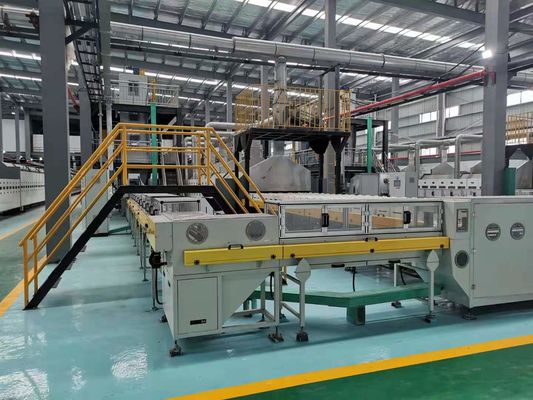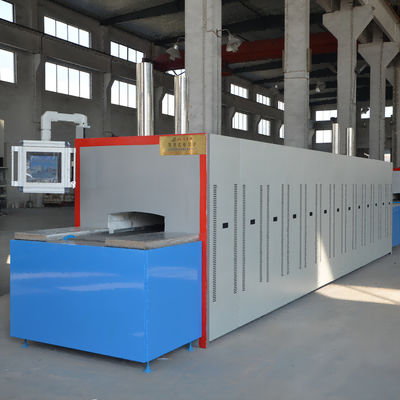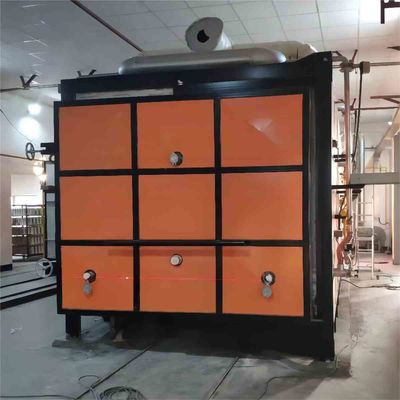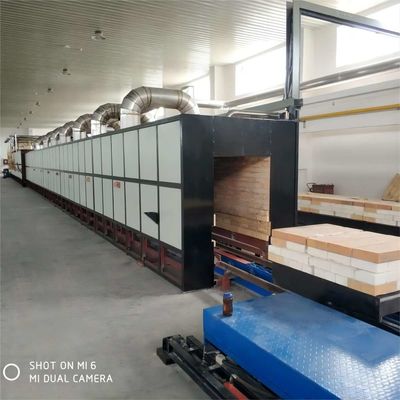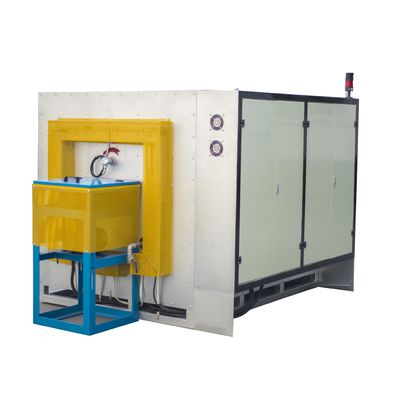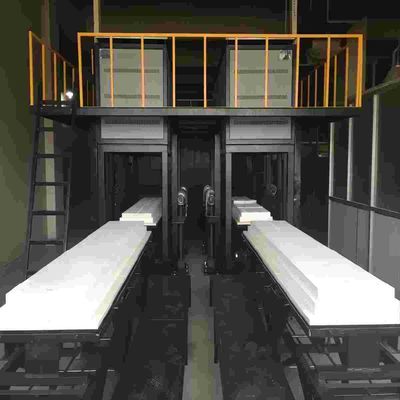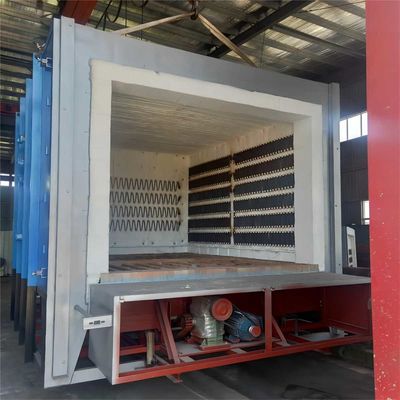Jiangsu Qianjin Furnace Industry Equipment Co., Ltd. also manufactures roller hearth furnaces specifically designed for processing cathode materials, which are essential components of lithium-ion batteries and other types of rechargeable batteries. Cathode materials, such as lithium cobalt oxide (LiCoO₂), nickel manganese cobalt (NMC), nickel cobalt aluminum (NCA), and lithium iron phosphate (LiFePO₄), require precise and controlled heat treatment processes to achieve the desired properties for optimal battery performance.
1.Roller Hearth Furnace for Cathode Material Processing
Cathode materials undergo high-temperature processing in order to achieve specific crystalline structures, improve performance, and increase the stability and energy density of the materials used in batteries. Jiangsu Qianjin’s roller hearth furnaces are well-suited for these continuous, high-temperature processes, offering precision, energy efficiency, and uniformity in heat distribution.
2.Key Roles of Roller Hearth Furnaces for Cathode Materials
2.1Sintering and Calcination:
Sintering: Cathode materials, particularly metal oxides like lithium cobalt oxide (LiCoO₂), require sintering at high temperatures to improve their structural integrity and electrochemical performance. A roller hearth furnace provides continuous sintering, ensuring uniform heat distribution to all parts of the material.
Calcination: In the case of composite cathode materials (such as NMC), the materials undergo a calcination process where raw powders are heated in the furnace to form the final crystalline cathode material. The precise control of temperature and atmosphere is crucial to achieve the desired properties, including high capacity and long cycle life for the batteries.
2.2Controlled Atmosphere:
Inert Gas Atmosphere: A controlled inert atmosphere (such as argon or nitrogen) is often used in the furnace to prevent the cathode material from oxidizing or reacting with ambient air during the high-temperature process.
Oxygen-Rich Atmosphere: In some cases, an oxygen-rich environment is required to facilitate the formation of certain cathode materials, such as LiCoO₂. The roller hearth furnace can be adjusted to accommodate these different atmospheric requirements.
2.3High-Temperature Processing:
Processing Temperatures: Cathode materials like LiCoO₂, LiMn₂O₄, and LiFePO₄ require temperatures of up to 1,000°C to 1,200°C during their synthesis or sintering process. Roller hearth furnaces are capable of maintaining these high temperatures over extended periods, which is essential for creating high-quality materials with the desired electrochemical properties.
2.4Uniform Heat Distribution:
Even Heat Distribution: The furnace uses rollers to transport the cathode materials through the heating zones, ensuring that all parts of the material are subjected to consistent heat. This is crucial for maintaining uniform particle sizes, uniform crystal structures, and preventing thermal gradients that could lead to defects in the cathode material.
Precise Temperature Control: Jiangsu Qianjin’s roller hearth furnaces are equipped with advanced temperature control systems, ensuring that the heat profile matches the specific requirements for each type of cathode material. These systems can automatically adjust the heating profile to meet strict production specifications.
2.5Energy Efficiency and Automation:
Energy-Saving Features: Given the high temperature requirements for sintering and calcination, Jiangsu Qianjin furnaces are designed with energy-efficient systems, including advanced insulation and heat recovery technologies. This helps to lower energy consumption during long, continuous runs.
Automated Control Systems: The furnace can be equipped with automated controls for process monitoring and adjustment, allowing for consistent and precise processing without the need for manual intervention.
3.Specific Applications of Roller Hearth Furnaces for Cathode Materials
3.1Lithium Cobalt Oxide (LiCoO₂):
LiCoO₂ is one of the most commonly used cathode materials for lithium-ion batteries, especially in consumer electronics. It requires precise control of temperature during its sintering process to ensure high energy density, stability, and cycle life. The roller hearth furnace ensures uniform heating, which is critical for achieving the high-quality crystalline structure needed for high-performance batteries.
3.2Nickel Manganese Cobalt (NMC):
NMC is a popular cathode material for electric vehicles (EVs) due to its high energy density, stability, and lower cost compared to LiCoO₂. The production of NMC cathode materials requires calcination and sintering at specific temperatures. Roller hearth furnaces are ideal for this process, providing continuous processing and controlled atmospheres, which ensure uniformity in the material’s structure and performance.
3.3Nickel Cobalt Aluminum (NCA):
NCA cathode materials are commonly used in high-capacity lithium-ion batteries for electric vehicles. These materials require high-temperature processing for proper sintering and crystal formation. Roller hearth furnaces can accommodate these processing conditions, offering energy efficiency and high throughput.
3.4Lithium Iron Phosphate (LiFePO₄):
LiFePO₄ is known for its safety and long cycle life, making it suitable for energy storage and electric vehicle applications. The sintering process for LiFePO₄ involves high temperatures, and the roller hearth furnace ensures even heat distribution and a controlled atmosphere to maintain the integrity and quality of the material.
3.5Manganese-Based Cathodes:
Cathodes made from materials like LiMn₂O₄ (Lithium Manganese Oxide) require careful sintering to enhance their electrochemical properties. The roller hearth furnace's precise control of the temperature and atmosphere ensures that manganese-based cathodes achieve the desired performance characteristics.
4.Benefits of Using Roller Hearth Furnaces for Cathode Materials
4.1Continuous Production:
Roller hearth furnaces are designed for continuous operation, which is ideal for the large-scale production of cathode materials. The materials can be processed in large batches, increasing throughput and productivity.
4.2Uniform and Consistent Quality:
The continuous and uniform heat distribution ensures that the cathode material is treated consistently across the entire batch, resulting in high-quality and reliable products for battery manufacturing.
4.3Energy Efficiency:
By incorporating heat recovery systems and advanced insulation materials, Jiangsu Qianjin’s roller hearth furnaces are designed to minimize energy consumption, making them cost-effective for large-scale production.
4.4Scalability:
These furnaces can be customized to meet the production needs of various sizes of cathode materials, whether for small laboratory batches or large commercial production. The flexibility of the furnace makes it suitable for a wide range of cathode material types and production volumes.
4.5Automated and Precise Process Control:
The automation and advanced control systems in these furnaces enable operators to precisely control the processing conditions, ensuring the final cathode material meets the stringent specifications required for high-performance batteries.
Jiangsu Qianjin Furnace Industry Equipment Co., Ltd.’s roller hearth furnaces are essential for the high-precision processing of cathode materials used in lithium-ion batteries. These furnaces are particularly well-suited for continuous sintering, calcination, and heat treatment of materials like LiCoO₂, NMC, LiFePO₄, and NCA. With uniform heating, controlled atmospheres, and energy-efficient designs, these furnaces provide the ideal environment for producing high-quality cathode materials that are crucial for the performance of advanced battery technologies.

 Your message must be between 20-3,000 characters!
Your message must be between 20-3,000 characters! Please check your E-mail!
Please check your E-mail!  Your message must be between 20-3,000 characters!
Your message must be between 20-3,000 characters! Please check your E-mail!
Please check your E-mail! 
